If you read my blogs, you know how much I love researching recipes online. Therefore, my inbox is flooded daily with recipes, food hacks and stories of anything food-related. One of my favorite resources for this is Food52. I’ve taken several of their recipes and added my own spin to them, as well as trying out new techniques that they suggest.
One such food hack/technique ended up in my email a few weeks ago, and I was immediately enthralled. It involved cooking bacon in the oven. But this method was all about how the bacon was cooked after a sudden power outage and the end results.
Before I get into the Food52 article, its results, along with my results, I want to talk about bacon cooked in the oven.
I didn’t discover the secret of cooking bacon in the oven on a sheet tray until my days in culinary school. And once I discovered the secret, it completely changed my entire way of cooking bacon forever.
I no longer had to spend minutes staring over a hot skillet, flipping and fidgeting with the bacon while it was sizzling in the pan, with grease spattering about, often times hitting my face or hands.
I have to admit that there is something quite special and nostalgic about frying bacon in an old-fashioned cast iron skillet. I grew up in a house of eight kids and waking up to the smell of bacon frying in the skillet on a Sunday morning was absolutely everything. The smell would waft upstairs from the kitchen to my bedroom. It was the alarm clock that mothers and grandmothers nationwide would use to rouse young sleeping minds from a deep sleep. But for my family of ten, it meant waiting for long stretches at a time until every piece of bacon was eventually cooked and put on a serving plate, before being allowed to dig in to feast on the crisp, fried bacon.
I remember the very first time I cooked bacon in the oven for my mother was at a family breakfast gathering at her home in Texas. I ended up making two sheet pans of bacon, one pork and the other turkey. My mother was fascinated by the technique, and I’m sure she wished she had known about it for those Sunday mornings when she would stand over a hot skillet frying bacon for what must have seemed like an eternity.
The Food52 article was titled This is the Only Way I Cook Bacon Now, Thanks to a Power Outage. Talk about a headline that immediately grabs your attention! I read the story and right away I knew that I had to experiment and try the method out for myself.
The author Gary Schiro, who left the city and was now residing in the country with his husband, had already experienced his share of power outages. But on a calm Saturday morning as he tucked the bacon on a sheet tray into the oven, ten minutes later the power went off. After a quick peek he decided to leave the bacon in the oven, thinking it would continue to cook with the residual heat from the hot oven and proceeded to complete the rest of that morning's breakfast on the outdoor grill. From what he wrote, it seems like he ended up with a really delicious breakfast. Over-easy eggs, cooked on the grill in a cast iron pan, toast charred on the grill made from country sourdough bread, and he mentioned that even the coffee from the automatic drip machine had retained enough adequate heat to make it to the breakfast table at a reasonable temperature. But what delighted him the most was the bacon. He wrote that the rashers of bacon, “sitting on that sheet pan with the heat slowly subsiding made for shatteringly crisp, perfectly stiff rashers of bacon”.
I just knew after reading that, I needed to try it myself.
I don’t eat bacon very often, but what I really liked from reading his article was knowing that I could cook off a pound of bacon, eat a couple of slices and store the leftovers in the fridge for later use. He even suggested pouring off the bacon fat and storing that. And as a reminder to use in the future, place it in a tightly sealed heatproof container and keep that next to the butter that you have stored in the fridge.
I prefer the taste of thick cut bacon, and was pleased to find out that it was also the preferred choice for this method.
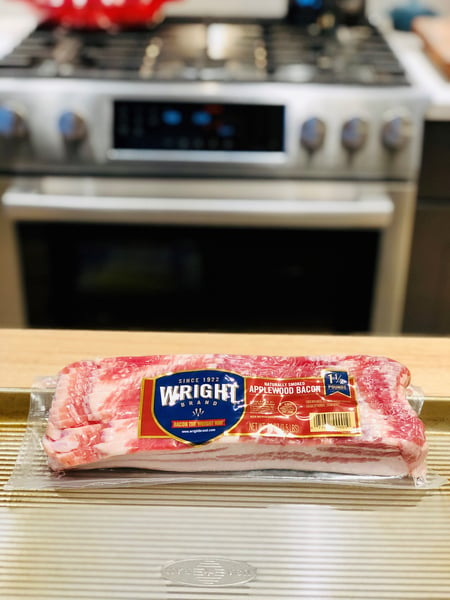
Gary’s accidentally newfound bacon technique requires preheating your oven to 400 degrees, and making sure that the oven rack is in the middle (if it’s too low, the bacon could scorch).
Place the strips of bacon on a heavy aluminum half sheet pan. (The bacon can be quite close, even touching, just not overlapping, if all of the strips don’t fit, set them aside for another time or for another use).
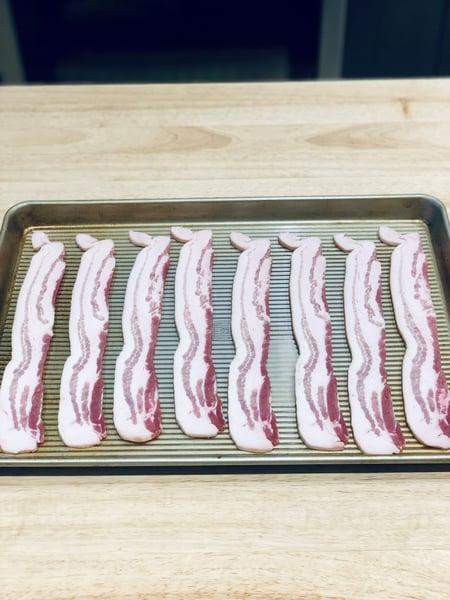
When the oven reaches 400 degrees, put the sheet pan with the strips of bacon in the middle rack of the oven and set the timer for 10 minutes.
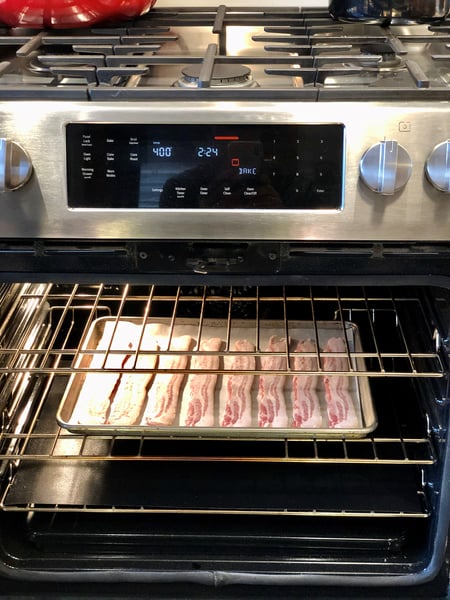
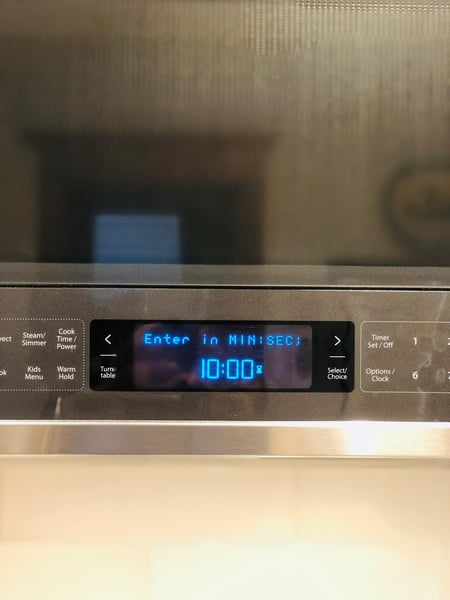
When the timer goes off, turn off the heat, leaving the bacon in the oven with the door closed. Gary mentions that it’s okay at this point to take a peek, but too much peeking will let out the heat too quickly and the results won’t be the same. He also suggests that if your oven bakes unevenly, rotate the sheet pan before cutting the heat off.
For Gary’s technique, he likes to leave the bacon in the oven for another 15 minutes, and sometimes even longer, and won’t start his eggs or toast until around that time so everything is warm when it comes to the table. He says that he’s even left the sheet tray in the oven a full 30 minutes before, and the bacon was still crisp and warm.
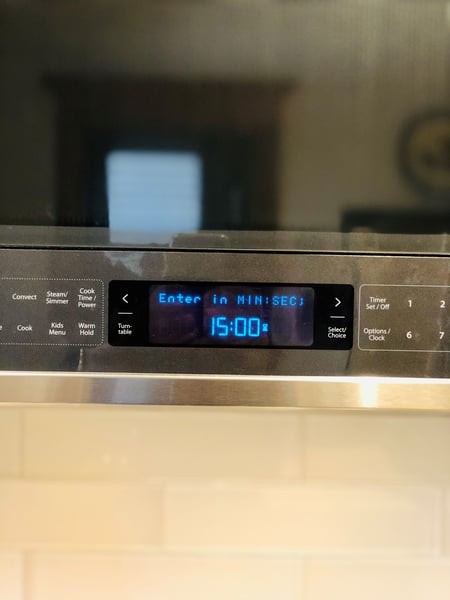
After sitting for more than 10 minutes once the oven is off, you’ll have slightly chewy, but crispy bacon. Five more minutes gives you bacon slightly crispier, but with less chew. And another five minutes delivers shatteringly crisp bacon. Using Gary’s technique of cooking bacon in the oven like this, resulted in rendering the fat low and slow ensuring maximal crispiness.
I followed Gary’s techniques as mentioned above exactly, which I just had one or two problems with, which resulted in my having to tweak his technique just a tiny bit.
In my initial experiment I did as Gary suggested and placed the bacon directly on the half sheet pan, placed the tray on the middle rack of a preheated 400-degree oven, and after 10 minutes I turned off the oven. Fifteen minutes later, I checked on the bacon slices and proceeded to remove two of them, so that I could let the other ones cook a while longer as part of the experiment to see how well they crisped up after further time in the oven. When I attempted to remove the two slices using a pair of tongs, I noticed that the bacon was sticking to the tray and they were extremely difficult to remove.
I decided to continue the experiment, but now with all the slices of bacon cooking in the residual heat of the oven all at the same pace. Ten minutes later I removed the pan and attempted once again to remove the slices of bacon to a paper towel lined plate. But the bacon was still sticking to the sheet pan, which resulted in my ending up with broken pieces of bacon, with some still left stuck to the pan.
My solution was to line the sheet tray with a sheet of parchment paper and cook the bacon exactly as Gary had instructed. It resulted in flat, crisp, chewy, perfectly cooked slices of bacon that were easily removable by tongs from pan to plate, without a problem.
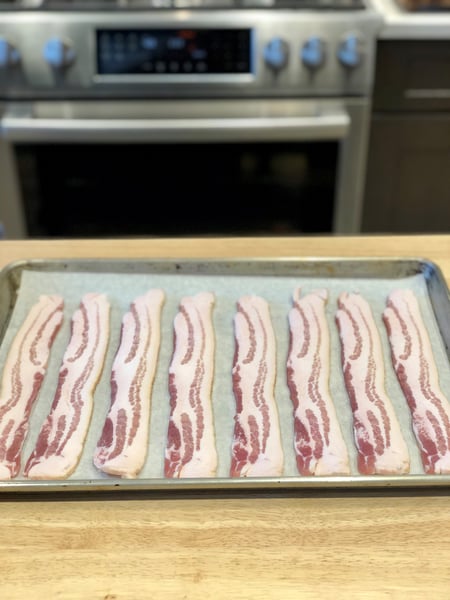
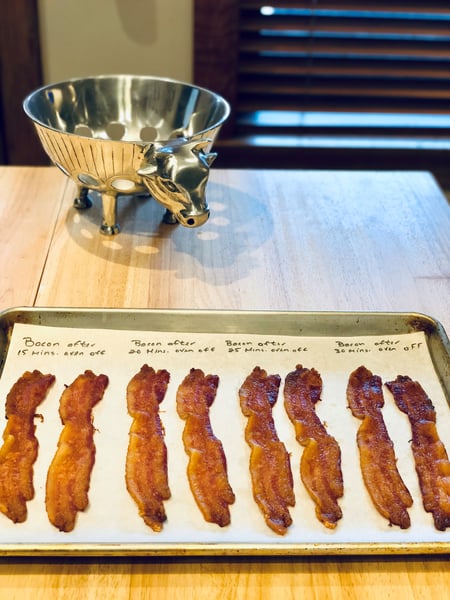
And for the home cook who doesn’t happen to have parchment paper on hand, I suggest using a piece of crumbled up aluminum foil to line your pan with. Make sure that the foil also extends over the edges of the pan, which will make clean up much easier. And because the foil is crumpled up, the fat from the bacon now has several nooks and crannies to reside in, making the transfer of bacon fat easier, which actually gives using foil a huge advantage over using parchment. This will be my next bacon experiment!
After allowing the bacon to cool, I wrapped two slices at a time in a piece of plastic wrap and placed all the wrapped pieces in a plastic freezer bag. Bacon wrapped and properly stored in the refrigerator will last 4 to 5 days and up to 4 months in the freezer.
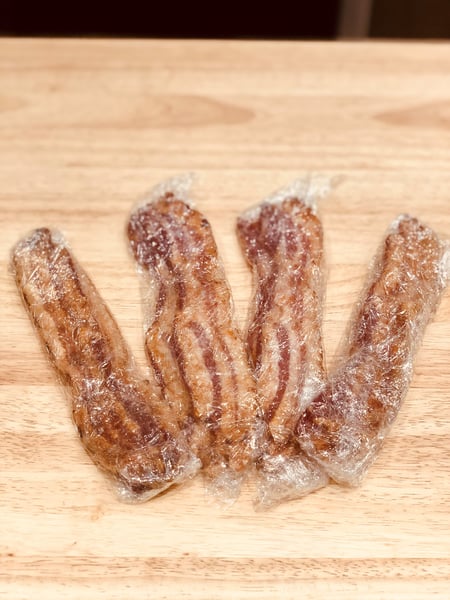
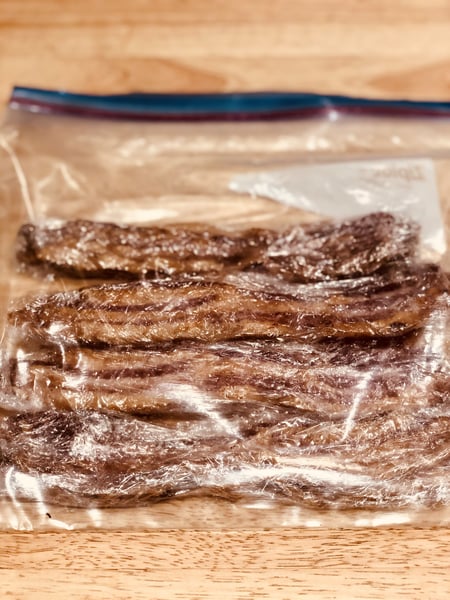
The next time I decide to make Belgian waffles using my brand-new cast-iron stove top waffle iron, all I’ll have to do is pull out how many slices of bacon I want, microwave them and breakfast is served. Which leads me into my next breakfast project. Making a bunch of Belgian waffles and freezing them to have on hand to place in the toaster for a speedy Sunday breakfast.
For more bacon fun, join us for The Chopping Block's Bloody Mary Brunch on Saturday, February 15 12pm at Lincoln Square.


